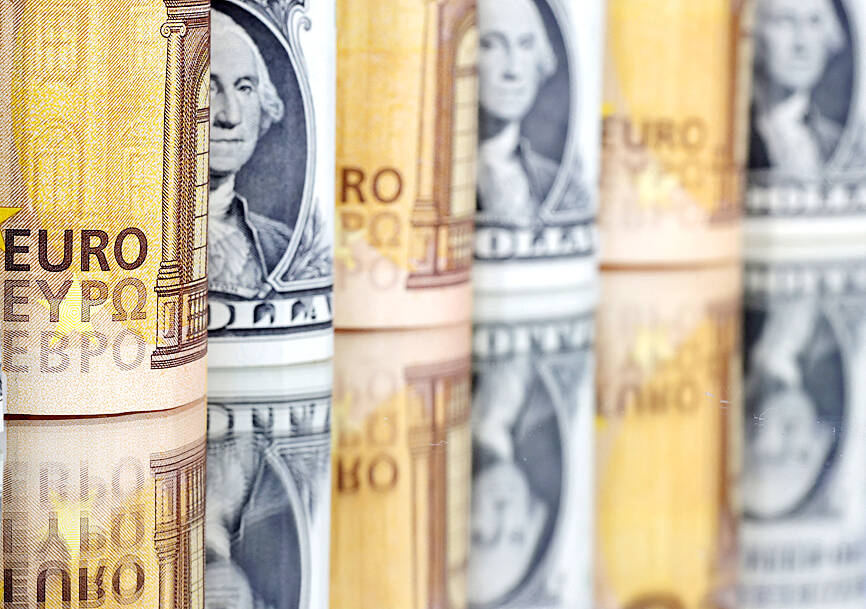The US dollar was little changed to slightly lower against major currencies on Friday, as business activity data suggested that the world’s largest economy remained resilient, supporting expectations of another 25 basis-point interest rate increase by the US Federal Reserve at next month’s policy meeting.
The US dollar index, which measures the performance of the US currency against six others, dropped 0.11 percent to 101.72, but rose 0.17 percent from a week earlier, posting its first weekly gain in nearly two months on rate increase expectations.
Data on Friday showed that S&P Global’s flash US Composite PMI Output Index, which tracks the manufacturing and services sectors, increased to 53.5 this month — the highest since May last year — following a final reading of 52.3 last month. It was the third straight month that the PMI remained above 50, indicating growth in the private sector.

Photo: Reuters
“Although economic activity is cooling, rate differentials are still dollar-supportive, and the US remains the cleanest dirty shirt on the global economic landscape,” said Karl Schamotta, chief market strategist at Corpay in Toronto.
In the case of the euro, a surprising recovery in the eurozone economy this month underpinned the currency.
However, the greenback’s outlook remained tilted to the downside as investors braced for the end of the Fed’s tightening cycle. Fed officials have been at pains to point out that inflation remains uncomfortably high and rates must keep rising.
Money markets on Friday continued to show expectations of a quarter-point US rate hike next month, which is US dollar-positive, followed by a pause in June. The rate futures market has also priced in rate cuts this year as the economy slows.
The New Taiwan dollar lost ground against the US dollar on Friday, declining NT$0.010 to close at NT$30.622, down 0.52 percent from a week earlier.
The euro rose 0.19 percent against the greenback to US$1.0992, recovering from a session low of US$1.0938, while sterling dipped 0.02 percent to US$1.2440, having dropped by as much as 0.54 percent earlier on.
The yen was one of the stronger performers earlier in the session, rising to a one-week high against the US dollar, amid data showing that Japanese consumer inflation held steady above the central bank’s target last month. That has put pressure on the Bank of Japan to ditch its ultra-loose monetary policy stance.
The US dollar was 0.08 percent lower against the Japanese yen at ¥134.14.
Additional reporting by CNA, with staff writer

Intel Corp chief executive officer Lip-Bu Tan (陳立武) is expected to meet with Taiwanese suppliers next month in conjunction with the opening of the Computex Taipei trade show, supply chain sources said on Monday. The visit, the first for Tan to Taiwan since assuming his new post last month, would be aimed at enhancing Intel’s ties with suppliers in Taiwan as he attempts to help turn around the struggling US chipmaker, the sources said. Tan is to hold a banquet to celebrate Intel’s 40-year presence in Taiwan before Computex opens on May 20 and invite dozens of Taiwanese suppliers to exchange views

Application-specific integrated circuit designer Faraday Technology Corp (智原) yesterday said that although revenue this quarter would decline 30 percent from last quarter, it retained its full-year forecast of revenue growth of 100 percent. The company attributed the quarterly drop to a slowdown in customers’ production of chips using Faraday’s advanced packaging technology. The company is still confident about its revenue growth this year, given its strong “design-win” — or the projects it won to help customers design their chips, Faraday president Steve Wang (王國雍) told an online earnings conference. “The design-win this year is better than we expected. We believe we will win

Chizuko Kimura has become the first female sushi chef in the world to win a Michelin star, fulfilling a promise she made to her dying husband to continue his legacy. The 54-year-old Japanese chef regained the Michelin star her late husband, Shunei Kimura, won three years ago for their Sushi Shunei restaurant in Paris. For Shunei Kimura, the star was a dream come true. However, the joy was short-lived. He died from cancer just three months later in June 2022. He was 65. The following year, the restaurant in the heart of Montmartre lost its star rating. Chizuko Kimura insisted that the new star is still down

While China’s leaders use their economic and political might to fight US President Donald Trump’s trade war “to the end,” its army of social media soldiers are embarking on a more humorous campaign online. Trump’s tariff blitz has seen Washington and Beijing impose eye-watering duties on imports from the other, fanning a standoff between the economic superpowers that has sparked global recession fears and sent markets into a tailspin. Trump says his policy is a response to years of being “ripped off” by other countries and aims to bring manufacturing to the US, forcing companies to employ US workers. However, China’s online warriors